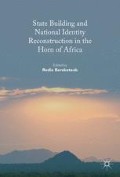Abstract
Chapter 10 examines national identity reconfiguration in South Sudan. It analyses the weakness and strength of national identity formation in the newborn country, and interrogates mechanisms of national identity reconfiguration following the split and associated with nation building in a pluralist society. It highlights those elements that strengthen national identity following a bloody independence struggle. It critically examines the role of factors such as language, religion, history, national consciousness, symbols and culture in the construction of post-secession national identity.
Access this chapter
Tax calculation will be finalised at checkout
Purchases are for personal use only
Notes
- 1.
Southern Sudan is the name used to refer to South Sudan before it achieved independence on 9 July 2011.
- 2.
The Mahdiyya or Mahdi revolution refers to the Islamic revolution led by the Imam Muhammad Ahmed Mahdi in the eighteenth century against Turco-Egyptian rule and later British colonialism. It was reported that Chief Chak Chak of Nyamlell sent his daughter Awet to Mahdi in recognition of the revolution. Mahdi renamed his new wife Magabolla, meaning “the gift accepted.”
- 3.
Arabi Juba originated in Juba town. It is a mixture of Arabic, English, Kiswahili and local dialects.
- 4.
Sudanisation was a policy introduced by the government just before independence whereby Sudanese nationals took over government positions from British and Egyptian administrators.
- 5.
The jallabiya is a long garment worn by Arab men, while the toub is a loose dress that covers a woman’s entire body, including her head.
- 6.
The Nasir faction refers to the movement that split from the SPLM/A and was led by Dr. Riek Machar and Dr. Lam Akol.
- 7.
This refers to a group of northerners who fought against Sudan alongside the Southern Sudanese and who formed SPLM-North after South Sudan’s secession.
- 8.
Kush is an ancient African kingdom situated between the Nile and its tributaries and mentioned in Isaiah v. 18 as a land of tall, black people. Some believe this is a prophetic reference to South Sudan and the South Sudanese people.
- 9.
Imatong is the tallest mountain in South Sudan and was known as a military training centre during the Anya Nya Rebellion. Many people think that, but for the mountain, the war of liberation would not have succeeded.
- 10.
Sudanile is a name once used by the Anya Nya liberators. Currently there is a Sudanile Party, which advocates this name change.
- 11.
Meaning “midpoint” in Dinka, a reference to its central location in the country.
References
Akol, L. (2009). SPLM/SPLA: Inside an African Revolution. Khartoum: Khartoum University Press.
Anderson, B. (1991). Imagined Community: Reflections on the Origin and Spread of Nationalism (Rev. ed.). London: Verso.
Arop, M. A. (2012). The Genesis of Political Consciousness in Southern Sudan. DBA: CreateSpace.
Bul, D. D. (2013). Working paper for National Healing, Peace and Reconciliation, Juba, July.
Dahbour, O. (2002, January). National identity: An argument for the strict definition. Public Affairs Quarterly, 16(1), 17–37.
Fluehr-Lobban, C. (2012). Shari’a and Islamism in Sudan: Conflict, Law and Social Transformation. London: I.B.Tauris.
Gellner, E. (1983). Nations and Nationalism. Oxford: Basil Blackwell.
Grawert, E. (Ed.). (2010). After the Comprehensive Peace Agreement in Sudan. Woodbridge and Rochester: James Currey.
Gudina, M. (2003). Ethiopia: Competing Ethnic Nationalism and the Quest for Democracy, 1860–2000. Addis Ababa: Shaker Publishing.
Harir, S. (1994). Recycling the past in the Sudan: An overview of the political decay. In S. Harir & T. Tvedt (Eds.), Short-Cut to Decay: The Case of the Sudan. Uppsala: The Nordic Africa Institute.
Hutchinson, J., & Smith, A. D. (Eds.). (1994). Nationalism. Oxford: Oxford University Press.
Johnson, D. H. (2003). The Root Causes of Sudan’s Civil Wars. Oxford: James Currey.
Jok, M. J. (2011). Diversity, unity, and nation building in South Sudan. Special Report. Retrieved from www.usip.org
Majok, Damazo D. (1990). The Northern Bahr al-Ghazal: People, Alien encroachment and rule, 1856–1956. Unpublished PhD dissertation, University of California.
Malwal, B. (2015). Sudan and South Sudan: From One to Two. Hamshire and New York: Palgrave Macmillan.
Moro, L. N. (2015). Second civil war: Creation of the united “New Sudan”. In R. Bereketeab (Ed.), Self-Determination and Secession in Africa: The Post-Colonial State. London and New York: Routledge.
Oromo, S. L. (2015). Sudan’s first civil war for self-determination. In R. Bereketeab (Ed.), Self-Determination and Secession in Africa: The Post-Colonial State. London and New York: Routledge.
Rolandsen, O. (2005). Guerrilla Government: Polical Change in the Southern Sudan During the 1990s. Uppsala: The Nordic Africa Institute.
Ross, P., & Paul, G. Retrieved from http://Wikipedia.org/wiki/ethnic_group
Smith, A. D. (1986). The Ethnic Origin of Nations. Oxford: Basil Blackwell.
Sorbo, G. M., & Ahmed, A. G. (Eds.). (2013). Sudan Divided: Continuing Conflict in a Contested State. New York: Palgrave Macmillan.
Wassara, S. S. (2015). Political history of Southern Sudan before independence of Sudan. In R. Bereketeab (Ed.), Self-Determination and Secession in Africa: The Post-Colonial State. London and New York: Routledge.
Weber, M. (1946). From Max Weber: Essays in Sociology. New York: Oxford University Press.
Wol, D. M. D. (2009). Politics of Ethnic Discrimination in Sudan: A Justification for the Secession of South Sudan. Kampala: Netmedia Publishers.
Young, J. (2012). The Fate of Sudan: The Origin and Consequences of a Flawed Peace Process. London and New York: Zed Books.
Author information
Authors and Affiliations
Editor information
Editors and Affiliations
Rights and permissions
Copyright information
© 2017 The Author(s)
About this chapter
Cite this chapter
Mathok, D. (2017). National Identity Reconfiguration in South Sudan: Strengths and Weaknesses. In: Bereketeab, R. (eds) State Building and National Identity Reconstruction in the Horn of Africa . Palgrave Macmillan, Cham. https://doi.org/10.1007/978-3-319-39892-1_10
Download citation
DOI: https://doi.org/10.1007/978-3-319-39892-1_10
Published:
Publisher Name: Palgrave Macmillan, Cham
Print ISBN: 978-3-319-39891-4
Online ISBN: 978-3-319-39892-1
eBook Packages: Political Science and International StudiesPolitical Science and International Studies (R0)

